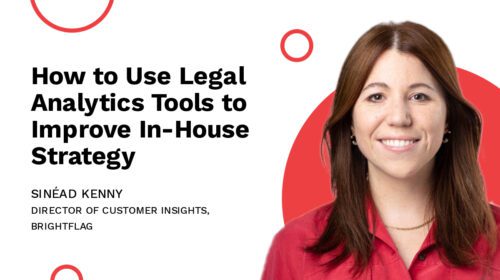How Legal Ops Can Add Predictability to the Annual Planning Process
Introducing predictability to the annual financial planning process often requires a delicate mix of both analytical and people management skills.
That’s because, in order to effectively formulate an in-house legal team’s annual budget for the upcoming year, you’ll have to both collect and interpret historical data on legal spend to better inform the budget, *and* coordinate with organizational stakeholders to anticipate upcoming changes that need to be financially accounted for.
Dawn Hinz is no stranger to this balancing act. In her role as Legal Operations Director at Avery Dennison, Dawn works tirelessly to plot out her legal department’s budget each year.
In a recent Brightflag webinar I hosted with her, “Navigating Annual Financial Planning,” Dawn shared a few of her tried-and-true strategies for ensuring an accurate and streamlined annual planning process.
Breaking Down Legal Spend
Budgeting becomes significantly harder when you don’t have a complete picture of all the key expense categories that legal spend is comprised of.
That’s why it’s often best to take a “divide and conquer” approach to analyzing past legal expenses—and planning for future spend—by separating expenses into buckets that will make getting your head around everything a lot easier.
“We focus on three key buckets, the first being headcount,” Dawn noted. “So that’s everything around the resource allocation department: salaries, benefits, things of that nature. Then we have travel and expenses and variable spend. So obviously, business-related travel and things such as memberships, meeting expenses, things of that nature. And then the primary bucket is legal fees. So all of our outside counsel spend and expenses related to even our legal technology road map.”
Unsurprisingly, legal fees is the category that Dawn recommends legal ops professionals pay the most attention to. And oftentimes planning for and keeping track of legal fees requires budget forecasts from law firms on the matters that they’re working on.
“Legal fees is the most in-depth. We really take into account inputs from outside counsel for projected spend on ongoing and new matters. And we do request them to submit budgets at the start of the matter, and then to reforecast on a quarterly basis.”
Regular Assessments and Reforecasting
As you might imagine, the process of reforecasting on a quarterly basis can be time-intensive. But as Dawn pointed out, it’s also one of the best ways to add some adaptability to your legal team’s budget.
“I think it’s a good way for us to track how things increase and decrease, and to take into account new learnings. Maybe something ends up costing a lot less than you thought it would. Maybe new matters come up that you had no visibility on when you were originally planning for the AOP (Annual Operating Plan). So it really provides an opportunity to true things up.”
These reforecasting opportunities also serve as regular assessments that can help inform legal spend management strategy going forward, while also providing valuable information for annual planning in future years.
“It gives us the lens to really analyze and strategize where things are at. Understanding what is the direction things are moving, and how do we kind of mitigate it, or push it in the direction that we want it to go?”
Legal Ops Leading the Charge
When it comes to annual budget planning, legal operations doesn’t carry the burden alone—everyone in the legal department plays a role. From internal matter leads to practice area heads, it requires a true team effort to keep a close eye on budget figures and ensure expenses are in line with forecasts.
That said, legal operations is usually tasked with stepping up and coordinating these efforts.
“[Our legal operations team] is really quarterbacking the process. We’re ensuring that information is complete and accurate, and provided at the right time. We have key deadlines, so backing into the AOP deadlines, we provide runway to give us time to really review.”
Oftentimes, this also involves legal ops taking the lead on analyzing spend too, in order to gain better insights into where things can be buttoned up and improved going forward.
More Annual Planning Insights
When it comes to streamlining the legal department’s annual planning process, the best practice recommendations that Dawn shared here are really just the start.
For more of Dawn’s expert insights—including tips on how to better collaborate with finance—check out the full “Navigating Annual Financial Planning” webinar.



